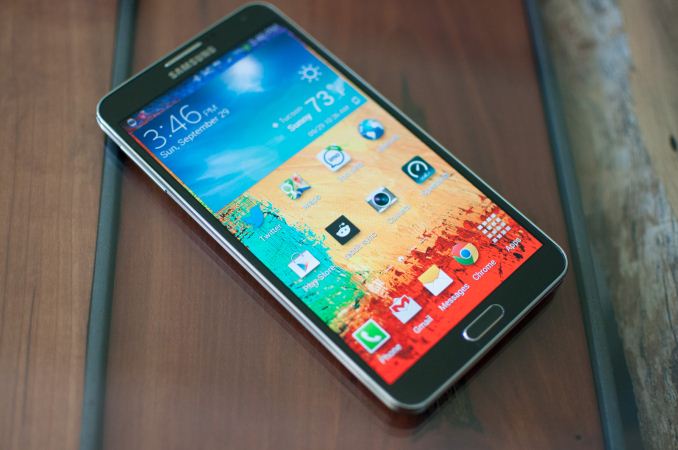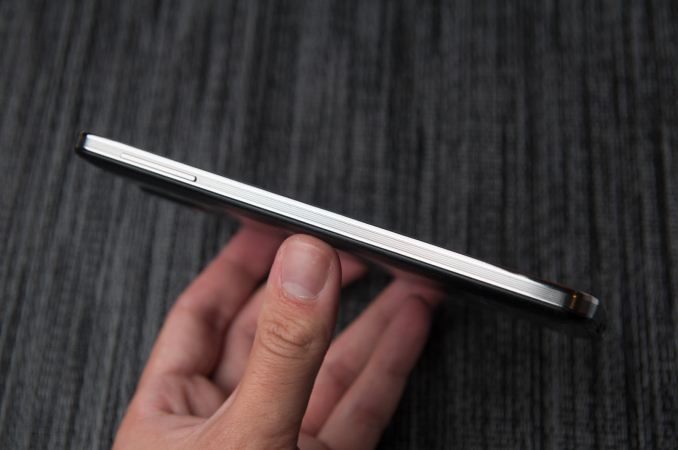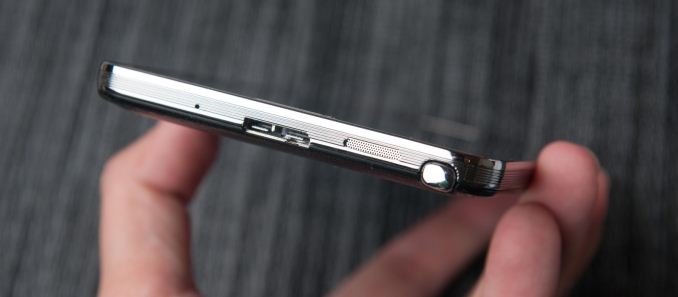Samsung Galaxy Note 3 Review
by Brian Klug on October 1, 2013 9:00 AM EST- Posted in
- Smartphones
- Samsung
- Mobile
- Android 4.3
- galaxy note 3

I still remember the first time I held the original Galaxy Note. At that point in time it wasn’t really obvious just how critical larger-display smartphones were going to be in the future, nor just how close the smartphone market was to becoming a mature one. In a mature market it’s all about filling in the niches, something Samsung has been doing since the very beginning by casting a very large form factor net with its lineup of android devices.
I remember being intrigued with the original Note more for the active digitizer feature (S-Pen) than the large display. It was during the height of the draw something craze, and having a stylus seemed like a logical advantage. Two years I lean the other way entirely, it’s that bigger display that makes me interested in the form factor not just as a curiosity but as something I actually want to use daily.
This is now Samsung’s third Galaxy Note, and as the adage goes hopefully third time is indeed a charm. Not that the first two weren’t wildly popular to begin with, either.
The Note 3 is obviously an iterative product with iterative improvements. The basic formula of the Note is unchanged - huge display, bumped specs versus the S series flagship, and active digitizer pen. The improvements this time are bigger display while making the overall device dimensions smaller, much faster SoC, higher resolution display, better camera, and all the improvements around the edges you’d expect (802.11ac, USB 3.0, IR).
I always start out by talking about the industrial design, appearance, and feel of devices, and won’t change that with the Note 3. Let’s just say it - the design of the Note 3 honestly isn’t a significant departure from Samsung’s norm. Then again nobody should’ve expected a huge departure to begin with.
Whereas the Note 2 felt and looked a lot like a blown up SGS3, the Note 3 is likewise a bit like a larger SGS4, although I honestly see bits of SGS2 in it. The front is home to the huge display, the same kind of earpiece grille we always see from Samsung, front facing camera, physical home button, and capacitive menu and back buttons.
The edge of the Note 3 is ringed with the familiar chrome, although this time there’s a ridge which makes it more grippy. With bigger phones making the edges less slippery is important, the Note 3 hits the mark here nicely.
All the buttons are also in the usual places for Samsung, and feel great. Power is easy to get to, the volume rocker as well is nicely positioned.
Headphone jack and the IR port are up top, along with one of the 3 microphones used for noise cancelation on the Note 3.
There’s another microphone on the bottom right of the device, and the third is at the bottom to the left of the microUSB 3.0 type B connector jack.
There’s been a lot of talk about the presence of USB 3.0, even though the micro B connector type has been around for considerable time already and in a ton of devices. The Note 3 just has the misfortune of apparently being many people’s first exposure to the connector, whose awkward double lobed shape gives it forwards compatibility with microUSB 2.0. The rightmost region is just the familiar microUSB 2.0 connector, the left contains the pins for SuperSpeed signaling for 3.0. Plug something into the right 2.0 jack and you get 2.0 speed for transfers and charging. 3.0 at present should give you faster transfer rate (it doesn't in practice as you'll soon see), and eventually faster charging, but the Note 3 continues to use Samsung’s 2.0 amp charging spec and rate, but more on that later.
|
Samsung Galaxy Note 3 (T-Mobile SM-N900T) |
|
| SoC |
2.3 GHz Qualcomm Snapdragon 800 (MSM8974) 4x Krait 400 @ 2.3 GHz, Adreno 330 at 450 MHz |
| Display | 5.7-inch Super AMOLED (1080p) |
| RAM | 3 GB LPDDR3 |
| WiFi | 802.11a/b/g/n/ac (BCM4339) + BT 4.0 |
| Storage | 32 / 64 GB + microSDXC (up to 64 GB) |
| I/O | microUSB 3.0, MHL 2.0, IR LED (remote), NFC |
| OS | Android 4.3 |
| Battery | 3200 mAh, 3.8V, 12.1 Whr |
| Size / Mass | 151.2 x 79.2 x 8.3mm, 168g |
| Camera |
13 MP w/AF, LED (Rear Facing) – 1080p60, 720p120, 4k30 2 MP (Front Facing) |
Whereas most of the Note 3 is par for the course for Samsung device design, the backside is something different entirely. Instead of the slick plastic that we normally get out of the Korean handset makers, the Note 3 backside material is plastic, textured to look like a leather bound book complete with faux stitching, and in the case of the black color, topped with a somewhat grippy rubbery finish. The white model doesn’t get that rubbery finish, and instead just feels like somewhat roughly textured plastic with the same faux leather pattern. I’ve held pleather, fake leather, and real leather, and this frankly isn’t any of that. It’s still injection molded plastic, but this time patterned so it looks vaguely leather.
Samsung does deserve kudos for not just giving us another slimy-backed phone with a glossy plastic battery cover, however. I have to admit I do like the rubber finish on the black Note 3 I was sampled, as the white one feels significantly different as it lacks that finish. The only downside is that it does pick up and show hand grease, whereas the white one handles it better. I could do without the fake stitching though.
I’ve been avoiding the discussion about the size of the Note 3 and whether it’s too big or too much. I’ve addressed this before in the Note 2 review, and I’d encourage you to read page 2’s “using a phablet” section, since the Note 3 is essentially the same situation, since it’s the same form factor. I can definitely use the form factor just fine, and the Note 3 comfortably. With the swipe keyboards that are popular now (I just use the stock Google Keyboard) I can even type one handed without much effort. In fact I’ve written a huge chunk of this review on the Note 3 in Draft, some of it one-handed.
Hands vary in size, and what size device is “best” for someone is really just a matter of personal taste. Some people are clamoring for smaller devices, others want bigger - as this market matures, success for OEMs will mean a diverse portfolio filling in all the obvious form factors.
More and more I’m starting to think the width of devices is the pain point that causes real fatigue, and edge bezel thickness. The Note 3 does very well here compared to its predecessor because it’s thinner, and lighter. In fact, you could pretty much sum up the Note 3 with – thinner, lighter, faster, oh and it has a bigger display at the same time.
|
Galaxy Note 3 (T-Mobile) |
Galaxy Note 2 (T-Mobile) |
Galaxy Note (AT&T) |
|
| Height | 151.2 mm | 151.1 mm | 146.85 mm |
| Width | 79.2 mm | 80.5 mm | 82.95 mm |
| Thickness | 8.3 mm | 9.4 mm | 9.65 mm |
| Mass | 168 grams | 180 grams | 178 grams |
| Display Size | 5.7-inch | 5.5-inches | 5.3-inches |
| Display Resolution | 1920 x 1080 | 1280 x 720 | 1280 x 800 |
| SoC | 2.3 GHz Snapdragon 800 (4x Krait 400) | 1.6 GHz Samsung Exynos 4412 (4x Cortex A9) |
1.4 GHz Qualcomm Snapdragon (APQ8060 - 2x Scorpion) |
| Camera | 13 MP with LED | 8 MP with LED | 8 MP with LED |
| Battery | 3200 mAh, 3.8V, 12.16 Whr | 3100 mAh, 3.8V, 11.78 Whr | 2500 mAh, 3.7V, 9.25 Whr |
I really want to use the Note 3 a lot more this time, since having more display real estate does make me feel like I can accomplish more. Obviously multimedia content also benefits from a larger viewport as well. Since I haven’t ever really been a tablet person, larger phones seem like a logical tradeoff.
Honestly the Note 3 feels better than its predecessor, and the biggest reasons for that are the textured rubberized back, grippier textured edge, thinner body, and thinner width. Oh and there’s no creakiness or build quality issues to speak of, in spite of being so large the Note 3 is very rigid and solid.




















302 Comments
View All Comments
barry spock - Tuesday, October 1, 2013 - link
I don't usually bother to comment here but I agree with the above comment. It doesn't matter if it's samsung or android that's playing funny buggers. The fact that the benchmarks are being tampered with it should be clearly stated in every review involved.Spunjji - Tuesday, October 8, 2013 - link
It was. Several times. Your comment is *utterly* pointless.bigpics - Wednesday, October 2, 2013 - link
Actually thanks to Anand Lal Shimpi and Brian Klug on this site we do know that it's almost everyone in Android world who matters at least (the article mentions LG, Asus and HTC): http://appleinsider.com/articles/13/10/02/asus-htc...As for others, the AppleInsider article quotes Andandtech as saying, "With the exception of Apple and Motorola literally every single OEM we’ve worked with ships (or has shipped) at least one device" that similarly fudges benchmarks."
That being said, I think it should be CLEARLY pointed out in every review of every such device if unfudgeable benchmarks can't be easily created (or until they are).
ESC2000 - Sunday, October 6, 2013 - link
In addition to running the benchmarks, Brian also commented extensively on his real world experience using the phone. So instead of getting your panties in a twist about unscrupulous approaches to benchmarks, why don't you focus on the real world performance that is much more informative and not affected by the benchmark issues? I'm betting that most of the panty-twisted people don't even use Samsung products but just feel the need to take them down a notch.Geronemo3 - Thursday, October 24, 2013 - link
He called it cheating more than a few times. Yes manufactures should stop this stupidity. Plus the benchmarks are for reference and we can maybe minus 10% performance from it. I don't remember the last time I purchased a smartphone just on benchmarks alone.Aenean144 - Tuesday, October 1, 2013 - link
Anand,As soon as you published the benchmark charts with the Note 3 sitting at the top, as the highest performant Android device, you've willingly assisted in Samsung's aims with their benchmark boosting processes. This is their goal. Even though you mention it in words, it's the charts that are important as the charts are linked and displayed far and wide across the Internet. The words will be quickly forgotten or are just unread as is typical in the attention deficit addled Internet.
It's unfair to the LG G2, the Sony Z1, likely to the Nexus 5, and to any other Snapdragon S800 device out there that don't employ the same tactics. There's no magic to Samsung's use of the S800 here. It should perform about the same as any other S800 device.
But by publishing the charts as you did in this review, you are being nothing but a sop to Samsung. Call it what it is. Cheating. Don't publish the benchmark comparison charts if you *know* that Samsung is cheating. Don't publish the charts if you know that others are cheating. Your customers are your readers, not Samsung, not LG, not Qualcomm, not Apple or whoever.
uvaman20 - Tuesday, October 1, 2013 - link
Aenean144 and others,I don't care about Samsung and their cheating and if Anandtech didnt bring the story YOU and prolly 98% of the people on the Earth wouldn't know about this so stop blaming them. Blame Engadet, Phonearena, GSMarena and others for that...They presented the idea and they published that (even they knew that Samsung will be pissed). We know they are "cheating" now and LIVE WITH THAT. Its the same shit with with car manufactures and consumption? Ask them why they cheating and go that long that you dont want to buy cheating car and I can bet you did... Look at browser games, they are all cheating and? Government is cheating us on a daily base and what we did? We know to Whine only...
Aenean144 - Tuesday, October 1, 2013 - link
Nobody here is blaming Anandtech. We're trying to push them to up their game, be consumer advocates, and not try to be a mouthpiece for these companies. Report the truth.Btw, it wasn't Anandtech that revealed the SGS4 benchmark boosting business. It was some dude working on SGS4 overclocking and who reported it on Beyond3D forums. Anandtech let it sit for month. It was Anandtech who made it part of the news cycle demonstrating the power of their platform. Now for the Note 3, it's Ars Technica who've really done the best benchmarking; while it seems that Anandtech is playing footsie with Samsung.
At times, Anandtech is entirely too politic about it. Call it what it is. If they want it to stop, call it what it is. Playing nicely or doing stuff behind the scenes isn't doing consumers any favors. If they see there are problems, run application benchmarks, look a video transcode.
dugbug - Tuesday, October 1, 2013 - link
Anand, why don't you just do what ARS did and attempt to create renamed benchmarks that sidestep their silly string matching game.vFunct - Tuesday, October 1, 2013 - link
Are you implying that Apple uses benchmark cheats like Samsung does?